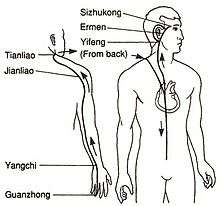San Jiao
| San Jiao | |||||||||||||||||
| Traditional Chinese | 三膲 | ||||||||||||||||
|---|---|---|---|---|---|---|---|---|---|---|---|---|---|---|---|---|---|
| Simplified Chinese | 三焦 | ||||||||||||||||
| |||||||||||||||||
| This article is part of a series on |
| Fringe medicine and medical conspiracy theories |
|---|
 |
|
General information |
|
San Jiao is a term found in traditional Chinese medicine (TCM), as part of the modelling of the workings of the human body attempted by early Chinese medical writers. References to it can be found in the oldest Chinese medical texts available, including the Huangdi Neijing. The identification of disease according to the Three Burners was first described in the Qing dynasty by Wu Jutong (吳鞠通, 1758–1836) in his book A Systematic Identification of Febrile Diseases..
This system is used within the practice of Chinese herbal medicine, in conjunction with acupuncture and other Chinese medicine (TCM) modalities. Note that the San Jiao theory differs slightly from the San Jiao organ, or channel [(Shou Shao Yang, san jiao jing)]; referred to additionally as "Triple Heater", San Jiao, and "Triple Burner". Viewed by Chinese Medicine as the passage of heat and fluid throughout the body, Elementary Questions (su wen) explains, "The Triple Burner holds the office of the sluices; it manifests as the waterways."
Diagnostics
The system is often combined with Four Stages theory when diagnosing and treating an externally contracted disease caused by a wind-heat pathogen. The disease will be diagnosed and understood according to its location within the three burners.
San Jiao has been translated as "triple heater", triple warmer (or three warmers)", and "triple burner", the latter of which is probably favored because of the involvement of the San Jiao in metabolism. The current World Health Organisation standard term is "Triple Energizer" (TE), but many authors still prefer to use San Jiao.
Body model
There is no organ in Western medicine which corresponds to San Jiao, but that is because Western medicine does not consider the connective tissue network to be an organ.
The Triple-Burner itself is the way in which the connective tissue divides up the Thoracic, Abdominal and Pelvic cavities.
These compartments are recognised as being medically distinct areas of the body which tend to wall off infection and bleeding.

- Upper Jiao (上焦)
- Middle Jiao (中焦)
- Lower Jiao (下焦)
Relationships
In TCM theory, the San Jiao is a yang organ paired with the pericardium (Xin Bao) which is the yin organ associated with it. Yang (Fu) organs are typically hollow, whereas yin (Zang) organs are more solid. The Triple Burner corresponds perfectly with the connective tissue network, as exemplified by fascia; and the three Burners represent the fascial compartments of pleura-pericardium (chest) peritoneum (abdomen) and retroperitoneum (pelvis). These anatomical compartments not only explain the Triple Burners but also precisely place the organs in the correct Burners e.g. The Kidney is in the retroperitoneum or Lower Burner.
The San Jiao's Hand-Foot partner is Dan (Gall Bladder meridian - ends on 4th digit on foot).
Function
The San Jiao is also said to be a metabolism mechanism similar to an old-fashioned water wheel that is turned by incoming water and creates energy qi for accomplishing a task, such as grinding grain in the case of the water wheel, or for metabolising and digesting food in the case of the San Jiao. The San Jiao is closely associated with the spleen functions of transformation and transportation, particularly the metabolism of incoming food. The San Jiao is also closely associated with the kidney's function in TCM. The San Jiao, however, is not limited to one metabolism function as the spleen or kidneys are, but is a general metaboliser which can be applied to a variety of metabolism needs.
Wu Xing
San Jiao is related to the "Ministerial(secondary) fire" element of the Chinese Five Elements.
See also
References
- Kaptchuk, T.J. Chinese Medicine: The Web that has no Weaver. 2000. London: Rider.
- Keown, D "The Spark in the Machine: How The Science of Acupuncture Explains the Mysteries of Western Medicine' 2014 Singing Dragon
- Maciocia, G. The Foundations of Chinese Medicine. 2000. Churchill Livingstone.
- Wiseman, N., Ye F. A Practical Dictionary of Chinese Medicine.1998. Paradigm Publications.